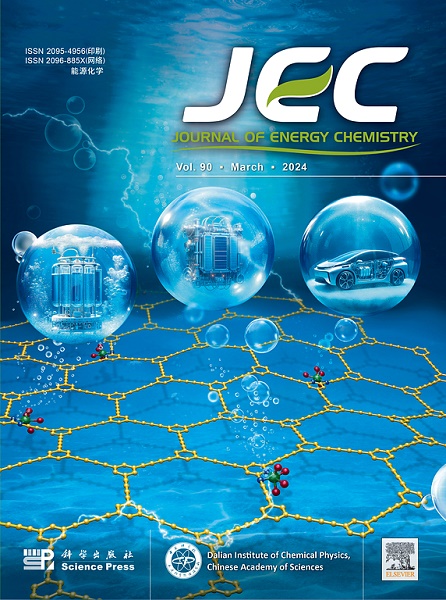A lignin-based polyelectrolyte with fast 3D Li+ transportation network
IF 13.1
1区 化学
Q1 Energy
引用次数: 0
Abstract
In this work, we have developed a lignin-derived polymer electrolyte (LSELi), which demonstrates exceptional ionic conductivity of 1.6 × 10−3 S cm−1 and a high cation transference number of 0.57 at 25 °C. Time of flight secondary ion mass spectrometry (TOF-SIMS) analysis shows that the large-size 1-ethyl-3-methylimidazolium cations (EMIM+) can induce the aggregation of the anionic segments in lignosulfonate to reconstruct the three-dimensional (3D) spatial structure of polyelectrolyte, thereby forming a fluent Li+ transport 3D network. Dielectric loss spectroscopy further reveals that within this transport network, Li+ transport is decoupled from the relaxation of lignosulfonate chain segments, exhibiting characteristics of rapid Li+ transport. Furthermore, in-situ distribution of relaxation times analysis indicates that a stable solid electrolyte interface layer is formed at the Li plating interface with LSELi, optimizing the Li plating interface and exhibiting low charge transfer impedance and stable Li plating and stripping. Thus, a substantially prolonged cycling stability and reversibility are obtained in the Li||LSELi||Li battery at 25 °C (1800 h at 0.1 mA cm−2, 0.1 mAh cm−2). At 25 °C, the Li||LSELi||LiFePO4 cell shows 132 mAh g−1 of capacity with 92.7% of retention over 120 cycles at 0.1 mA cm−2.

具有快速3D Li+传输网络的木质素基聚电解质
在这项工作中,我们开发了一种木质素衍生的聚合物电解质(LSELi),它在25°C时具有1.6 × 10−3 S cm−1的优异离子电导率和0.57的高阳离子转移数。飞行时间二次离子质谱(TOF-SIMS)分析表明,大尺寸的1-乙基-3-甲基咪唑阳离子(EMIM+)可以诱导木质素磺酸盐中的阴离子片段聚集,重建聚电解质的三维(3D)空间结构,从而形成一个流畅的Li+输运三维网络。介质损耗谱进一步揭示,在该输运网络中,Li+输运与木质素磺酸盐链段的弛豫解耦,表现出Li+快速输运的特征。此外,弛豫时间的原位分布分析表明,LSELi在镀锂界面处形成了稳定的固体电解质界面层,优化了镀锂界面,表现出低电荷转移阻抗和稳定的镀锂剥离。因此,在25°C (1800 h, 0.1 mA cm - 2, 0.1 mAh cm - 2)下,Li||LSELi||锂电池获得了相当长的循环稳定性和可逆性。在25°C下,Li||LSELi||LiFePO4电池的容量为132 mAh g−1,在0.1 mA cm−2下循环120次后保持率为92.7%。
本文章由计算机程序翻译,如有差异,请以英文原文为准。
求助全文
约1分钟内获得全文
求助全文
来源期刊

Journal of Energy Chemistry
CHEMISTRY, APPLIED-CHEMISTRY, PHYSICAL
CiteScore
19.10
自引率
8.40%
发文量
3631
审稿时长
15 days
期刊介绍:
The Journal of Energy Chemistry, the official publication of Science Press and the Dalian Institute of Chemical Physics, Chinese Academy of Sciences, serves as a platform for reporting creative research and innovative applications in energy chemistry. It mainly reports on creative researches and innovative applications of chemical conversions of fossil energy, carbon dioxide, electrochemical energy and hydrogen energy, as well as the conversions of biomass and solar energy related with chemical issues to promote academic exchanges in the field of energy chemistry and to accelerate the exploration, research and development of energy science and technologies.
This journal focuses on original research papers covering various topics within energy chemistry worldwide, including:
Optimized utilization of fossil energy
Hydrogen energy
Conversion and storage of electrochemical energy
Capture, storage, and chemical conversion of carbon dioxide
Materials and nanotechnologies for energy conversion and storage
Chemistry in biomass conversion
Chemistry in the utilization of solar energy
 求助内容:
求助内容: 应助结果提醒方式:
应助结果提醒方式:


